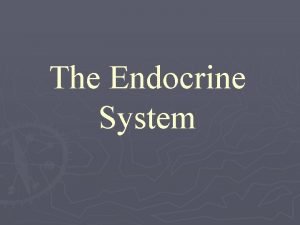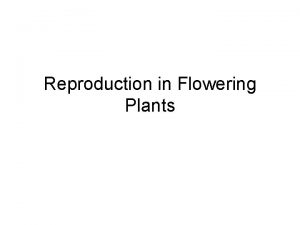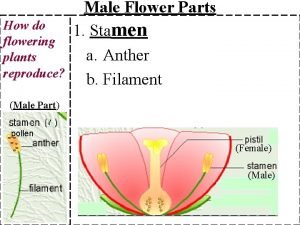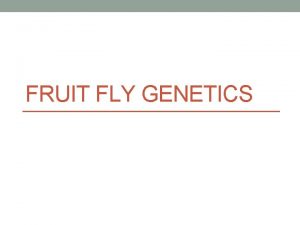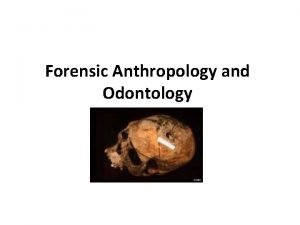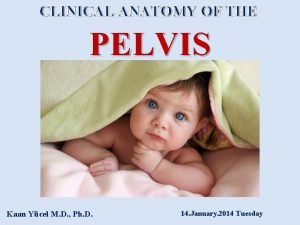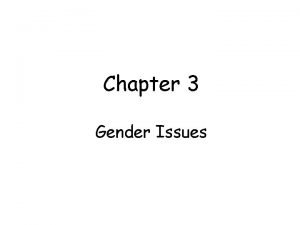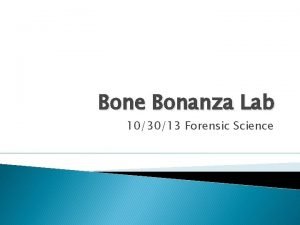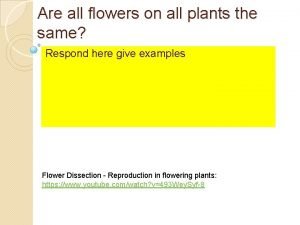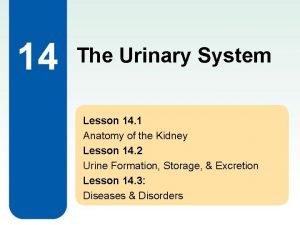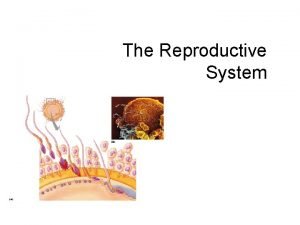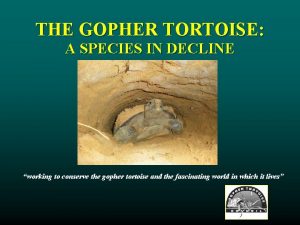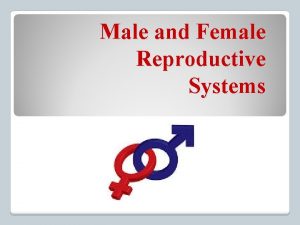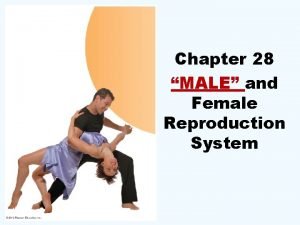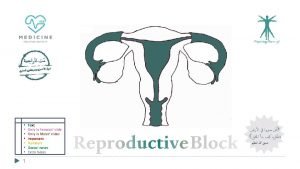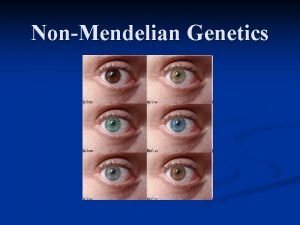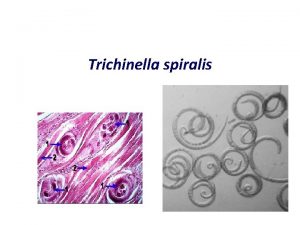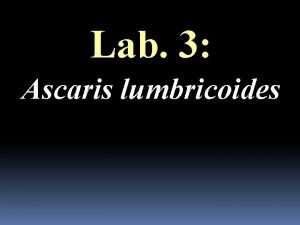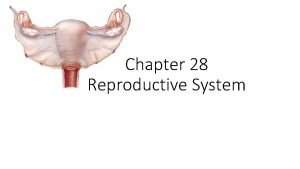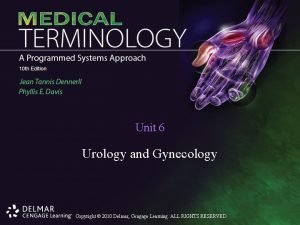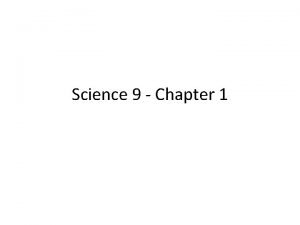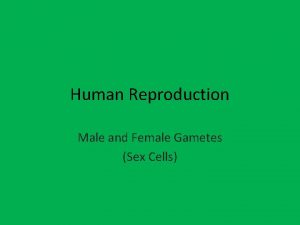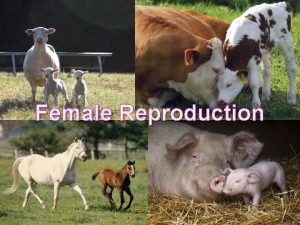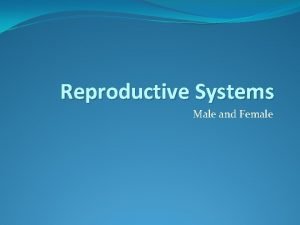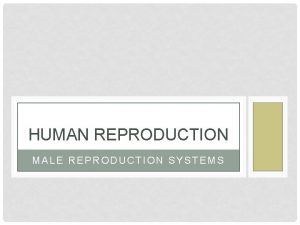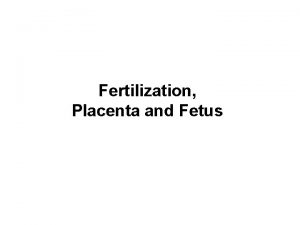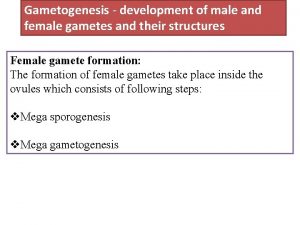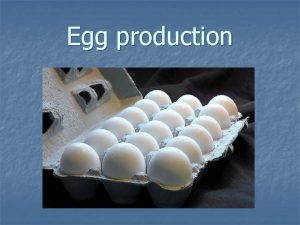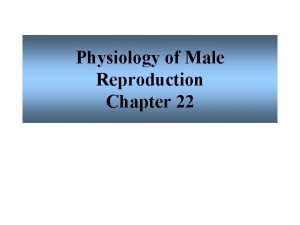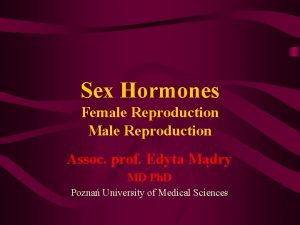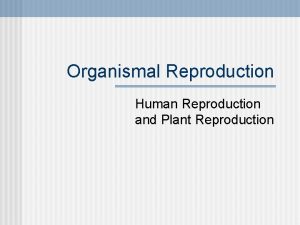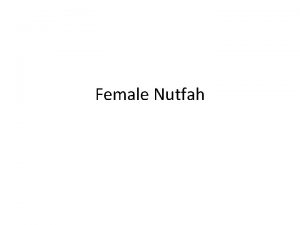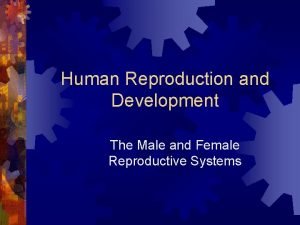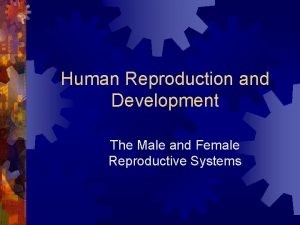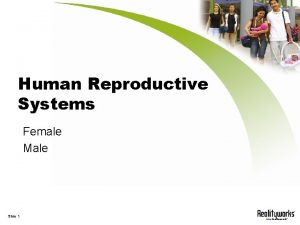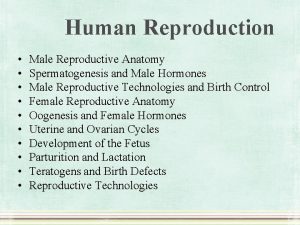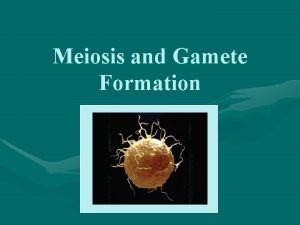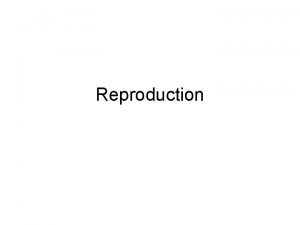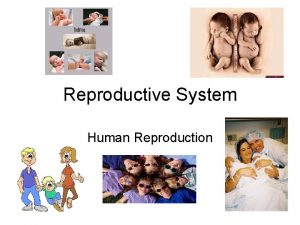Human reproduction Male and female gametes Egg 23































- Slides: 31

Human reproduction

Male and female gametes Egg 23 chromosomes Sperm The human life cycle 46 chromosomes Cells fuse to form a fertilised egg

SIZE COMPARISONS 10 microns (0. 01 mm) VIRUS (0. 05 to 0. 1 microns) BACTERIA 100 microns (0. 5 to 1. 5 microns) RED BLOOD CELL (5 microns) WHITE BLOOD CELL (5 to 8 microns) SPERM (60 microns) OVUM

Bladder Prostate Gland Penis Gland for making seminal fluid Sperm duct Scrotum Testis

Male Gamete – Sperm head middle piece tail brings about movement vesicle contains enzymes involved in penetration of ovum during fertilization Nucleus containing DNA mitochondria which release energy during respiration

Sperm carry a nucleus in the head 300 million produced during intercourse Released in a liquid called semen


Secondary Sexual Characters • During puberty – boy : hair in pubic and facial regions larynx growth, voice break muscular development girl : breast development hips widen more fat under skin menstruation


Menstrual Cycle | Generally about every 28 days | The uterus lining becomes thickened 14 days after menstruation to prepare for the fertilized ovum to implant in it | Uterus : ±thickening of lining ±menstruation (discharge of lining if no fertilization)

Menstrual Cycle • Day 1 - 5 – Menstruation starts – Uterus lining decreases in thickness to a minimum

Menstrual Cycle |Day 6 - 14 – Lining becomes thicker with increased blood supply – Day 14 : ovulation

Menstrual Cycle |Day 14 - 28 – Lining remains thick to ready for implantation of fertilized ovum

Menstrual Cycle |Day 28 – No implantation of fertilization ovum – Uterus lining breaks down – menstruation starts

Fertilization 1 st day oviduct ovary uterus 2 nd day cervix vagina 6 th day 3 rd day 4 th day

sperms


Events Happened after fertilization | Sperms reach the upper part of the fallopian tube | Egg is fertilized at the fallopian tube | Fertilized egg is carried to the uterus | After reaching the uterus, the embryo fixed firmly onto the thick uterus wall – Implantation

Ovulation and fertilization

Placenta

Functions of the Placenta • The placenta is an organ that is made up of tissues from the mother and the baby. • It allows food and oxygen to pass from the mother to the baby. • It allows waste to pass from the baby to the mother for removal. • Harmful substances such as drugs and alcohol can also pass in to the baby and cause damage.

Embryo at 2 weeks

Embryo at 4 weeks

Embryo at 8 weeks

Development of Human Foetus uterus foetus placenta umbilical cord amniotic fluid

Functions of Uterus |During embryo development – Protect the embryo – Provide a constant environment for the embryo to develop – Allow placenta to attach on |During birth of baby – Push the baby out by muscular contraction

Birth • At the end of the pregnancy the womb begins to contract and labour begins. • These contractions cause the amniotic sac to burst and the amniotic fluid to be released – “the breaking of the waters” • The cervix and the vagina expand or dilate. • The contractions of the womb push the baby out through the vagina and it is born. • The umbilical clamped and cut. • The contractions of the womb continue and they push out the placenta and umbilical cord. This called the afterbirth.

Labour and birth

Contraception • Contraception is any method that tries to prevent fertilisation or pregnancy occur. • There are 2 types of contraception – Natural methods – abstinence and avoiding sex during the fertile period. – Artificial methods – artificially preventing sperm meeting egg or implantation.

Artificial Methods • Female – Tying or cutting of fallopian tubes – Taking “the pill” – prevents ovulation – IUD (the coil) – prevents implantation – Diaphragm (the cap) – prevents the sperm entering the uterus/fallopian tubes • Male – Vasectomy – cutting the sperm duct, no sperm released into vagina – Condom – prevents sperm being released into vagina

Contraception
 Sexual reproduction and asexual reproduction
Sexual reproduction and asexual reproduction Seminal tubules
Seminal tubules Major endocrine glands male and female
Major endocrine glands male and female Chapter 16 matching questions 1-5
Chapter 16 matching questions 1-5 Male fallopian tube
Male fallopian tube Selective breeding
Selective breeding Blood types dominant and recessive
Blood types dominant and recessive Male flower
Male flower Part of the flower that produces pollen
Part of the flower that produces pollen Difference between male and female drosophila
Difference between male and female drosophila Difference between male and female skulls
Difference between male and female skulls How many teeth are in a human mouth
How many teeth are in a human mouth Male part of flower
Male part of flower Smallest anteroposterior diameter of the pelvic inlet
Smallest anteroposterior diameter of the pelvic inlet Sex male and female
Sex male and female Bone bonanza lab
Bone bonanza lab Difference between male and female sharks
Difference between male and female sharks Female parts of a flower
Female parts of a flower What do male ladybugs look like
What do male ladybugs look like Lesson 14.2 male and female urinary structures
Lesson 14.2 male and female urinary structures Differences between male and female reproductive organ
Differences between male and female reproductive organ Male and female tortoise
Male and female tortoise Male and female hormones
Male and female hormones Drawing of the male and female reproductive system
Drawing of the male and female reproductive system Male and female hormones
Male and female hormones Codominance
Codominance Trichinella spiralis male and female
Trichinella spiralis male and female An 82 kg male and a 48 kg female
An 82 kg male and a 48 kg female Larva
Larva Penis glans
Penis glans Copyright
Copyright Plant and animal reproduction venn diagram
Plant and animal reproduction venn diagram


